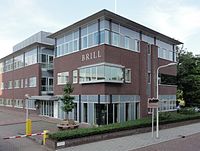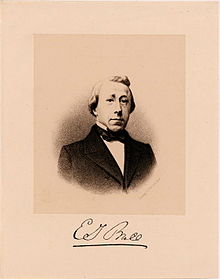Brill Publishers
It has been suggested that Rodopi (publisher) be merged into this article. (Discuss) Proposed since November 2020. |
It has been suggested that Martinus Nijhoff Publishers be merged into this article. (Discuss) Proposed since November 2020. |
hideThis article has multiple issues. Please help or discuss these issues on the talk page. (Learn how and when to remove these template messages)
|
 | |
| Traded as | Euronext: BRILL |
|---|---|
| Founded | 1683 |
| Founder | Jordaan Luchtmans |
| Country of origin | Netherlands |
| Headquarters location | Leiden |
| Distribution | Turpin Distribution[1] |
| Publication types | Books, academic journals |
| Imprints | Global Oriental, Hotei Publishing, Brill Nijhoff, Brill Hes & De Graaf, Brill Rodopi |
| Official website | brill |
Brill (Euronext: BRILL) (known as E. J. Brill, Koninklijke Brill, Brill Academic Publishers) is a Dutch international academic publisher founded in 1683 in Leiden, Netherlands. With offices in Leiden, Boston, Paderborn and Singapore, Brill today publishes 275 journals and around 1200 new books and reference works each year. In addition, Brill provides of primary source materials online and on microform for researchers in the humanities and social sciences.

Areas of publication[]
Brill publishes in the following subject areas:
- Humanities:
- African Studies
- American Studies
- Ancient Near East and Egypt Studies
- Archaeology, Art & Architecture
- Asian Studies (Hotei Publishing and Global Oriental imprints)
- Classical Studies
- Education
- Jewish Studies
- Literature and Cultural Studies (under the Brill-Rodopi imprint)
- Media Studies
- Middle East and Islamic Studies
- Philosophy
- Religious Studies
- Slavic and Eurasian Studies
- Law (under the Brill-Nijhoff imprint):
- Human Rights and Humanitarian Law
- International Law
- International Relations
- Sciences:
- Biology
- Social Sciences
- Anthropology
- Cartography
- History
- Language and Linguistics
- Political Science
- Sociology
- Ecclesiology
- Biblical Studies and Early Christianity
- Theology and World Christianity
History[]
Luchtmans, 1683–1848[]
The roots of Brill go back to 17 May 1683, when the Leiden booksellers' guild registered Jordaan Luchtmans as a bookseller.[2] As was customary at the time, Luchtmans combined his bookselling business with publishing, primarily in the fields of biblical studies, theology, Asian languages, and ethnography. Luchtmans established close ties with the University of Leiden, which was then a major center of study in these areas.
E. J. Brill, 1848–1896[]

In 1848, the business passed from the Luchtmans family to former employee E. J. (Evert Jan) Brill. In order to cover the financial obligations that he inherited, E. J. Brill liquidated the entire Luchtmans book stock in a series of auctions that took place between 1848 and 1850.[3] Brill continued to publish in the traditional core areas of the company, with occasional excursions into other fields. Thus, in 1882, the firm brought out a two-volume Leerboek der Stoomwerktuigkunde ("Handbook of Steam Engineering"). More programmatically, however, in 1855 Het Gebed des Heeren in veertien talen ("The Lord's Prayer in Fourteen Languages") was meant to publicize Brill's ability to typeset non-Latin alphabets, including Hebrew, Aramaic, Samaritan, Sanskrit, Coptic, Syriac, and Arabic, among others.[4]
Brill goes public, 1896–1945; World War II[]
In 1896, Brill became a public limited company, when E. J. Brill's successors, A. P. M. van Oordt and Frans de Stoppelaar, both businessmen with some academic background and interest, died. A series of directors followed, until Theunis Folkers took over the reins in 1934.[5] At the time, the annual turnover was 132,000 guilders.[6] His directorship marked a period of unprecedented growth in the history of the company, due to a large extent to Folkers' cooperation with the German occupying forces during World War II. For the Germans, Brill printed foreign-language textbooks so that they could manage the territories they occupied, but also military manuals, such as "a manual which trained German officers to distinguish the insignias of the Russian army".[5] By 1943, the company's turnover had reached 579,000 guilders.[6]
Brill's recent history, 1945–present[]
After the war, the Dutch denazification committee determined the presence of "enemy money" in Brill's accounts. Folkers was arrested in September 1946, and deprived of the right to hold a managerial post.[7] The company itself, however, escaped the aftermath of the war relatively unscathed; after some negotiation its fines were fixed at 57,000 guilders.[8]
Brill's path in the post-war years was again marked by ups and downs, though the company remained faithful in its commitment to scholarly publishing. The late 1980s brought an acute crisis due to over-expansion, poor management, as well as general changes in the publishing industry. Thus, in 1988–91 under new management the company underwent a major restructuring, in the course of which it closed some of its foreign offices, including Cologne. Its London branch was already closed by then. Brill, moreover, sold its printing business, which amounted "to amputat[ing] its own limb".[9] This was considered painful, but necessary to save the company as a whole. No jobs were lost in the process. The reorganization saved the company, which has since expanded. As of 2008, Brill was publishing around 600 books and 100 journals each year, with a turnover of 26 million euros.[10]
Open access[]
Brill publishes several open access journals[11] and is one of thirteen publishers to participate in the Knowledge Unlatched pilot, a global library consortium approach to funding open access books.[12]
In 2013, Brill created the IFLA/Brill Open Access Award for initiatives in the area of open access monograph publishing together with the International Federation of Library Associations and Institutions.[13]
Brill is a member of the Open Access Scholarly Publishers Association.
Brill Typeface[]
Brill has developed a commercial font, free for personal use, that supports most of the Latin, Greek and Cyrillic character ranges, including IPA and historical forms. It has better diacritic rendering than most pre-packaged computer fonts, though not complete IPA coverage.[14]
See also[]
- List of Brill academic journals
- Books in the Netherlands
Notes[]
- ^ Ordering from Brill
- ^ Sytze van der Veen, Brill: 325 Years of Scholarly Publishing (Leiden: Brill, 2008), ISBN 978-90-04-17032-2), p. 11.
- ^ van der Veen, 45.
- ^ van der Veen, 51.
- ^ Jump up to: a b van der Veen, 108.
- ^ Jump up to: a b van der Veen, 103 and 109.
- ^ van der Veen, 111.
- ^ van der Veen, 115.
- ^ van der Veen, 144.
- ^ van der Veen, 153.
- ^ "Open Access with Brill". brill.com.
- ^ "KU Select For Publishers". knowledgeunlatched.org.
- ^ "Brill and IFLA announce new OA prize". researchinformation.info.
- ^ Brill Typeface
References[]
- The most up-to-date history of the company is Sytze van der Veen, Brill: 325 Years of Scholarly Publishing (Leiden: Brill, 2008), ISBN 978-90-04-17032-2
- Verde, Tom. "Brill's Bridge to Arabic", Aramco World, 66 (May/June 2015), nr. 3, pp. 30–39. Archived version.
External links[]
- 1683 establishments in the Dutch Republic
- Academic publishing companies
- Book publishing companies of the Netherlands
- Companies established in 1683
- Companies listed on Euronext Amsterdam
- Companies based in Leiden
- Mass media in Leiden
- Publishing companies established in the 17th century
- Brill Publishers academic journals